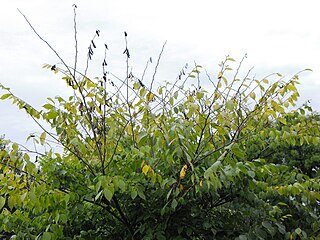
A bark beetle is one of about 220 genera with 6,000 species of beetles in the subfamily Scolytinae. Traditionally, this was considered a distinct family Scolytidae, but is now understood to be very specialized members of the "true weevil" family (Curculionidae). Well-known species are members of the type genus Scolytus, namely the European elm bark beetle S. multistriatus and the large elm bark beetle S. scolytus, which like the American elm bark beetle Hylurgopinus rufipes, transmit Dutch elm disease fungi (Ophiostoma). The mountain pine beetle Dendroctonus ponderosae, southern pine beetle Dendroctonus frontalis, and their near relatives are major pests of conifer forests in North America. A similarly aggressive species in Europe is the spruce ips Ips typographus. A tiny bark beetle, the coffee berry borer, Hypothenemus hampei is a major pest on coffee plantations around the world.
A kairomone is a semiochemical, emitted by an organism, which mediates interspecific interactions in a way that benefits an individual of another species which receives it, and harms the emitter. This "eavesdropping" is often disadvantageous to the producer. The kairomone improves the fitness of the recipient and in this respect differs from an allomone and a synomone. The term is mostly used in the field of entomology. Two main ecological cues are provided by kairomones; they generally either indicate a food source for the receiver, or the presence of a predator, the latter of which is less common or at least less studied.

Aradidae bear the appropriate common name, flat bugs, in reference to their (usually) extremely flattened body. With few exceptions, these often cryptic insects are of no economic importance. Common temperate genera include Aradus, Mezira, Neuroctenus, and Aneurus.

The ant beetle, also known as the European red-bellied clerid, is a medium size insect, rather soft-bodied, with strong mandibles that can tear between the hard sclerotized integument of bark beetles. Larvae and adults are common predators of bark beetles in Europe.
The Chinese Elm cultivar Ulmus parvifolia 'Matthew' is one of three American introductions selected for their cold hardiness.
The Chinese Elm cultivar Ulmus parvifolia 'Milliken' is another American introduction.
The Chinese Elm cultivar Ulmus parvifolia 'Pathfinder' is another development by A. M. Townsend of the USDA National Arboretum registered in 1990.

The Chinese Elm cultivar Ulmus parvifolia 'King's Choice' is one of the early American selections best known for its winter hardiness, able to withstand temperatures of -30 deg. Celsius. 'King's Choice' was patented in 1985.
The Chinese Elm cultivar Ulmus parvifolia 'Cork Bark' is a North American clone.
The Chinese Elm cultivar Ulmus parvifolia 'State Fair' was cloned from a tree growing in the grounds of the Oklahoma State Fair, Oklahoma City.
The Chinese Elm cultivar Ulmus parvifolia 'Stone's Dwarf' was commercially released in the USA in 1978.
The Chinese Elm cultivar Ulmus parvifolia 'The Thinker' was selected by M. Hayman from a tree on the campus of the University of Louisville, Kentucky.
The Chinese Elm cultivar Ulmus parvifolia 'Burnley Select' was grown from seed taken from a tree at the Burnley (horticultural) College, University of Melbourne and selected by Dr Peter May.

Xanthogaleruca luteola, commonly known as the elm-leaf beetle, is an invasive beetle pest species in the family Chrysomelidae.

A pheromone trap is a type of insect trap that uses pheromones to lure insects. Sex pheromones and aggregating pheromones are the most common types used. A pheromone-impregnated lure, as the red rubber septa in the picture, is encased in a conventional trap such as a bottle trap, Delta trap, water-pan trap, or funnel trap. Pheromone traps are used both to count insect populations by sampling, and to trap pests such as clothes moths to destroy them.

Scolytus is a genus of bark beetles. It includes several species notorious for destroying trees in the forests. The Dutch elm disease is spread in North America by two species : the native elm bark beetle, Hylurgopinus rufipes, and the European elm bark beetle, Scolytus multistriatus. In Europe, while the aforementioned Scolytus multistriatus again acts as vector for infection, it is much less effective than the large elm bark beetle Scolytus scolytus.
The Chinese Elm Ulmus parvifolia cultivar 'Small Frye' is to be released by Plant Introductions Inc. of Georgia

The European spruce bark beetle, is a species of beetle in the weevil subfamily Scolytinae, the bark beetles, and is found from Europe to Asia Minor and some parts of Africa.

Ips is a genus of beetles in the family Curculionidae, the true weevils. They are bark beetles, members of the subfamily Scolytinae. Species are distributed throughout the Northern Hemisphere. Some are known as introduced species in Australia and Africa. Many species are pests of forest trees, especially pines and spruces. They are known commonly as engraver beetles, ips engraver beetles, and pine engravers.











